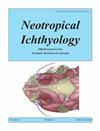旗舰种巴西盐(dourado)保护策略的重要性(特征:苔藓科)
IF 2
4区 生物学
Q1 ZOOLOGY
引用次数: 1
摘要
摘要在paran本文章由计算机程序翻译,如有差异,请以英文原文为准。
Importance of protection strategies in the conservation of the flagship species “dourado” Salminus brasiliensis (Characiformes: Bryconidae)
Abstract In the upper Paraná River floodplain, the populations of Salminus brasiliensis have been subjected to several anthropic impacts, such as overfishing, the blocking of migratory routes by dams, and regulation of the flood regime. Its populations have disappeared or become depleted in most rivers in this basin. These populations are the target of protection measures aimed at restoring them. This study evaluated the abundance of this species in the upper Paraná River floodplain over a 26-year time series in sites under different degrees of protection. Despite the overall decrease in the abundance of S. brasiliensis across the region, the less impacted sites have higher abundances and exhibited a slower decline in the probability of occurrence. Over time, populations in less impacted sites also exhibited improved fish condition. Some protected areas in the upper Paraná River have had a mitigation effect by lowering the velocity of population decline and representing a constant source of propagule production for other areas. Our results reinforce the notion that populations threatened with low abundances take a long time to effectively recover their stocks. Thus, besides evaluating species conservation strategies, long-term studies are essential to subsidize management measures, such as fisheries regulations.
求助全文
通过发布文献求助,成功后即可免费获取论文全文。
去求助
来源期刊

Neotropical Ichthyology
生物-动物学
CiteScore
2.80
自引率
17.60%
发文量
24
审稿时长
6-12 weeks
期刊介绍:
Neotropical Ichthyology is the official journal of the Sociedade Brasileira de Ictiologia (SBI). It is an international peer-reviewed Open Access periodical that publishes original articles and reviews exclusively on Neotropical freshwater and marine fishes and constitutes an International Forum to disclose and discuss results of original research on the diversity of marine, estuarine and freshwater Neotropical fishes.
-Frequency: Four issues per year published only online since 2020, using the ‘rolling pass’ system, which posts articles online immediately as soon as they are ready for publication. A searchable and citable Digital Object Identifier (DOI) is assigned to each article immediately after online publication, with no need to await the issue’s closing.
-Areas of interest: Biology, Biochemistry and Physiology, Ecology, Ethology, Genetics and Molecular Biology, Systematics.
-Peer review process: The Editor-in-Chief screens each manuscript submitted to Neotropical Ichthyology to verify whether it is within the journal’s scope and policy, presents original research and follows the journal’s guidelines. After passing through the initial screening, articles are assigned to a Section Editor, who then assigns an Associate Editor to start the single blind review process.
 求助内容:
求助内容: 应助结果提醒方式:
应助结果提醒方式:


